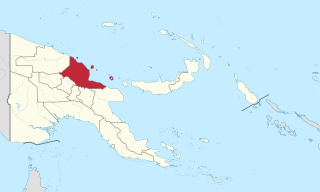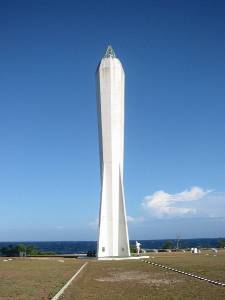Related Research Articles

Madang is a province of Papua New Guinea. The province is on the northern coast of mainland Papua New Guinea and has many of the country's highest peaks, active volcanoes and its biggest mix of languages. The capital is the town of Madang.

Madang is the capital of Madang Province and is a town with a population of 27,420 on the north coast of Papua New Guinea. It was first settled by the Germans in the 19th century.
Matukar is an Austronesian language spoken by about 400 people near Madang town, Madang Province, Papua New Guinea. It is universally spoken by its ethnic group.

Madang Football Club, formerly known as Madang Flying Fox, Madang Niupetro Fox or simply Madang Fox, was a Papua New Guinea football club, based in Madang.
The Yaganon languages are a small family of closely related languages in New Guinea. They were linked with the Rai Coast languages in 1951 by Arthur Capell in his Madang family, but separated out again by Timothy Usher. The family is named after the Yaganon River.
The Rai Coast languages are a family of languages in the Madang stock of New Guinea.

The Madang or Madang–Adelbert Range languages are a language family of Papua New Guinea. They were classified as a branch of Trans–New Guinea by Stephen Wurm, followed by Malcolm Ross. William A. Foley concurs that it is "highly likely" that the Madang languages are part of TNG, although the pronouns, the usual basis for classification in TNG, have been "replaced" in Madang. Timothy Usher finds that Madang is closest to the Upper Yuat River languages and other families to its west, but does not for now address whether this larger group forms part of the TNG family.
Kursav is a divergent and nearly extinct Madang language of the Adelbert Range of Papua New Guinea. It was once placed in the now-defunct Brahman branch of Madang. Daniels (2017) identifies Gants as its closest relative.

Mauwake (Mawake), or Ulingan, is a Papuan language of Madang Province, Papua New Guinea. It is spoken in several villages along the north coast of Madang province, which lies in the north-east of Papua New Guinea.
Bargam, or Mugil, is a Papuan language of Madang Province, Papua New Guinea, spoken mainly by adults. It is divergent within the Madang language family.
Apalɨ (Apal), or Emerum, is a Papuan language of Madang Province, Papua New Guinea. Akɨ and Acɨ are two dialects that are quite different from each other.
Saep is a Madang language spoken in Madang Province, Papua New Guinea.
Wasembo, also known as Biapim, Gusap, and Yankowan, is a Madang language spoken in Madang Province, Papua New Guinea. Usher classifies it as being closest to the Yaganon languages.
Yabong is a Madang language spoken in Madang Province, Papua New Guinea.
Male is a Madang language spoken in Madang Province, Papua New Guinea.
Bongu is a Madang language spoken in Madang Province, Papua New Guinea.
Bagupi is a nearly extinct Madang language of Papua New Guinea. The language is under pressure from neighboring large languages such as Garuh, and Tok Pisin, which is taking its toll. Spoken in the Madang Province of Papua New Guinea. Spoken at the headwaters of the Gogol River, west of Mabanob, northwest of Madang town. Very little is still known about this unique language situated in Papua New Guinea.
GGL may refer to:

Rai Coast Rural LLG is a local-level government (LLG) of Madang Province, Papua New Guinea.
Yamben (Yaben) is a Trans–New Guinea language of Madang Province, Papua New Guinea. It was first documented by Andrew Pick in the 2010s and classified by Pick (2019) as a probable primary branch of Madang, though its precise classification is still pending further research. Although surrounded by Croisilles languages, Yamben is not one of them.
References
- ↑ Ganglau at Ethnologue (18th ed., 2015)